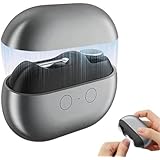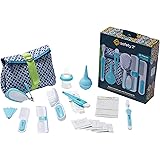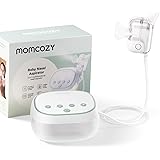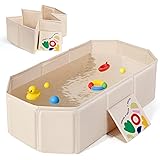Did you know that infants can experience up to seven colds in their first year of life? A stuffy nose is a common and often distressing symptom for both babies and their parents. Witnessing your little one struggle to breathe or feed can be incredibly challenging. Fortunately, effective solutions exist to provide much-needed baby stuffy nose relief.
The video above demonstrates a simple yet highly effective tool: the manual nasal aspirator, sometimes affectionately called a “snot sucker.” This device is a true game-changer for parents whose babies are too young to blow their own noses. It provides a gentle and immediate way to clear those tiny, congested airways, promoting better breathing and comfort for your child.
Understanding Your Baby’s Stuffy Nose: Why It Happens
A baby’s tiny nasal passages are much more susceptible to congestion than an adult’s. Their immune systems are still developing, making them more prone to common colds and viruses. Moreover, babies spend a significant amount of time lying flat, which can make mucus accumulation more pronounced and difficult to drain naturally.
Imagine a small, narrow pipe. Even a tiny blockage can prevent water from flowing freely. Similarly, a small amount of mucus in a baby’s nose can significantly impact their ability to breathe. This can disrupt their feeding, sleep patterns, and overall demeanor, turning a usually cheerful baby into a fussy, uncomfortable one.
The Importance of Clearing Infant Congestion
Clearing your baby’s stuffy nose is not just about comfort; it is crucial for their well-being. Babies are obligate nasal breathers, meaning they primarily breathe through their noses, especially when feeding. A blocked nose can make nursing or bottle-feeding very difficult, as they cannot breathe and suck simultaneously.
Furthermore, prolonged nasal congestion can disrupt sleep, leading to overtiredness and irritability. In some cases, it can even contribute to ear infections if mucus backs up. Therefore, proactively managing a baby’s stuffy nose is an essential part of infant care, ensuring they remain healthy and happy.
Introducing the Nasal Aspirator: A Gentle Solution
A nasal aspirator is specifically designed to safely and gently remove excess mucus from a baby’s nasal passages. While various types exist, the manual parent-suck aspirator, as shown in the video, is a popular choice due to its effectiveness and direct control. This type features a tube with a soft nozzle for the baby’s nostril and a mouthpiece for the parent to gently suck, creating suction.
A common concern for parents is the hygiene aspect, wondering if mucus might enter their mouth. Fortunately, these aspirators are engineered with a disposable filter. This critical component acts like a safety screen, much like a sieve preventing solid particles from passing through a liquid. It ensures that no mucus or germs travel up the tube to the parent’s mouth, providing peace of mind during use.
How to Effectively Use a Manual Nasal Aspirator
Using a nasal aspirator correctly is key to providing optimal baby stuffy nose relief. It is a straightforward process, but a few steps can enhance its effectiveness:
Step-by-Step Guide for Clearing Baby’s Nose
- Preparation is Key: Begin by making sure your baby is comfortable and secure. Holding them in an upright or semi-upright position can help with drainage.
- Consider Saline Drops: For thicker mucus, administer 1-2 drops of saline solution into each nostril a few minutes before using the aspirator. This thins the mucus, making it easier to remove.
- Position the Aspirator: Gently place the soft tip of the aspirator into one of your baby’s nostrils. Ensure it forms a seal without pushing too far in.
- Gentle Suction: Place the other end of the tube into your mouth and apply gentle, continuous suction. You will hear and see the mucus being drawn into the aspirator’s collection chamber.
- Repeat as Needed: Remove the aspirator, clear the tip if necessary, and repeat for the other nostril. You may need to repeat the process a few times for each nostril until the airways are clear.
- Clean Thoroughly: After each use, disassemble the aspirator and wash all parts with warm, soapy water. Rinse thoroughly and allow to air dry completely to prevent bacterial growth. Replace the filter as directed by the manufacturer.
It is important to remember that babies might not always enjoy this process. However, the temporary discomfort is often outweighed by the immediate relief they experience. Maintaining a calm and reassuring demeanor can help both you and your baby through the process.
Beyond the Aspirator: Additional Tips for Infant Congestion
While a nasal aspirator is an excellent tool, several other methods can complement its use and provide comprehensive infant congestion relief. Combining these approaches can significantly improve your baby’s comfort.
Further Strategies for Baby Breathing Comfort
- Use a Humidifier: Placing a cool-mist humidifier in your baby’s room can add moisture to the air. This helps to thin mucus, making it easier for your baby to breathe and for the aspirator to work effectively. It’s like adding moisture to a dry sponge to make it more pliable.
- Steam Therapy: Take your baby into a steamy bathroom for 10-15 minutes. The warm, moist air can help loosen congestion in their nasal passages and chest. Ensure the room is warm but not excessively hot.
- Elevate Their Head: When your baby is sleeping, slightly elevate the head of their crib mattress. You can do this by placing a towel or pillow *under* the mattress (never directly in the crib with the baby). This gravitational assistance helps mucus drain.
- Frequent Feeding: Continue to offer fluids frequently. Breast milk or formula helps keep babies hydrated, which is crucial for thinning mucus and supporting their immune system.
- Gentle Chest Rubs: A very gentle massage on your baby’s chest and back can sometimes help dislodge mucus. Ensure any products used are specifically formulated for infants and follow package directions carefully.
By employing a combination of these strategies, you can significantly enhance your baby’s comfort and support their recovery from a stuffy nose. Always consult with your pediatrician if your baby’s symptoms worsen, persist, or if you have any concerns about their health. Providing effective baby stuffy nose relief is a cornerstone of nurturing care for your little one.











